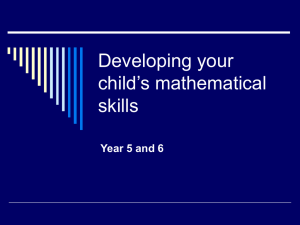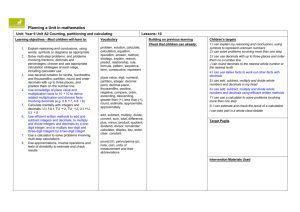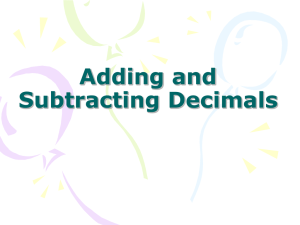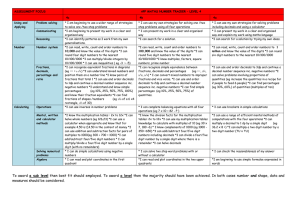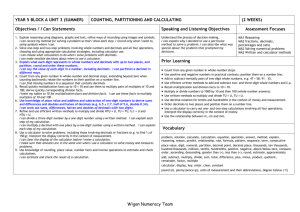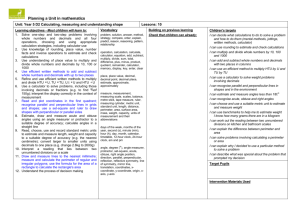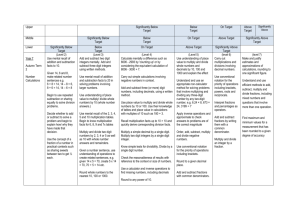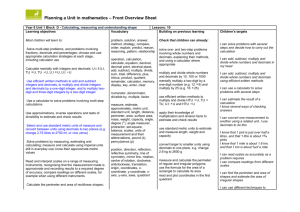Unit: Year 5 A2 Counting partitioning and calculating
advertisement
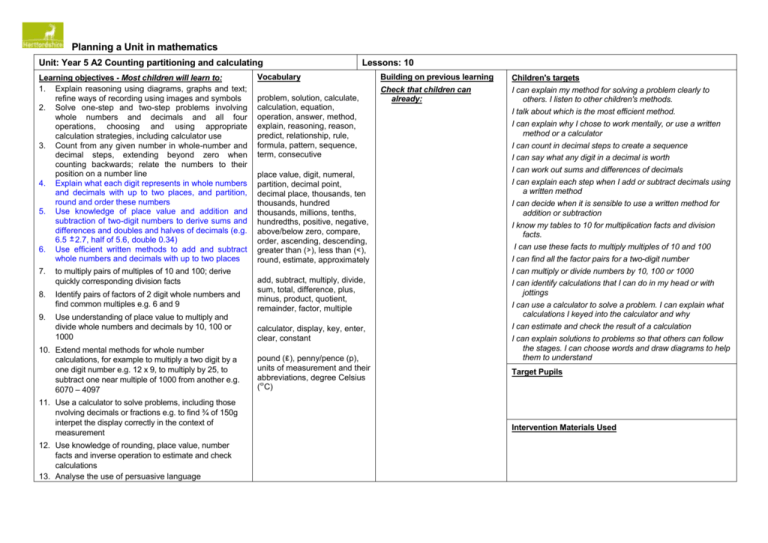
Planning a Unit in mathematics Unit: Year 5 A2 Counting partitioning and calculating Learning objectives - Most children will learn to: 1. Explain reasoning using diagrams, graphs and text; refine ways of recording using images and symbols 2. Solve one-step and two-step problems involving whole numbers and decimals and all four operations, choosing and using appropriate calculation strategies, including calculator use 3. Count from any given number in whole-number and decimal steps, extending beyond zero when counting backwards; relate the numbers to their position on a number line 4. Explain what each digit represents in whole numbers and decimals with up to two places, and partition, round and order these numbers 5. Use knowledge of place value and addition and subtraction of two-digit numbers to derive sums and differences and doubles and halves of decimals (e.g. 6.5 2.7, half of 5.6, double 0.34) 6. Use efficient written methods to add and subtract whole numbers and decimals with up to two places 7. to multiply pairs of multiples of 10 and 100; derive quickly corresponding division facts 8. Identify pairs of factors of 2 digit whole numbers and find common multiples e.g. 6 and 9 9. Use understanding of place value to multiply and divide whole numbers and decimals by 10, 100 or 1000 10. Extend mental methods for whole number calculations, for example to multiply a two digit by a one digit number e.g. 12 x 9, to multiply by 25, to subtract one near multiple of 1000 from another e.g. 6070 – 4097 11. Use a calculator to solve problems, including those nvolving decimals or fractions e.g. to find ¾ of 150g interpet the display correctly in the context of measurement 12. Use knowledge of rounding, place value, number facts and inverse operation to estimate and check calculations 13. Analyse the use of persuasive language Lessons: 10 Vocabulary problem, solution, calculate, calculation, equation, operation, answer, method, explain, reasoning, reason, predict, relationship, rule, formula, pattern, sequence, term, consecutive place value, digit, numeral, partition, decimal point, decimal place, thousands, ten thousands, hundred thousands, millions, tenths, hundredths, positive, negative, above/below zero, compare, order, ascending, descending, greater than ( ), less than ( ), round, estimate, approximately add, subtract, multiply, divide, sum, total, difference, plus, minus, product, quotient, remainder, factor, multiple calculator, display, key, enter, clear, constant pound ( ), penny/pence (p), units of measurement and their abbreviations, degree Celsius ( C) Building on previous learning Check that children can already: Children's targets I can explain my method for solving a problem clearly to others. I listen to other children's methods. I talk about which is the most efficient method. I can explain why I chose to work mentally, or use a written method or a calculator I can count in decimal steps to create a sequence I can say what any digit in a decimal is worth I can work out sums and differences of decimals I can explain each step when I add or subtract decimals using a written method I can decide when it is sensible to use a written method for addition or subtraction I know my tables to 10 for multiplication facts and division facts. I can use these facts to multiply multiples of 10 and 100 I can find all the factor pairs for a two-digit number I can multiply or divide numbers by 10, 100 or 1000 I can identify calculations that I can do in my head or with jottings I can use a calculator to solve a problem. I can explain what calculations I keyed into the calculator and why I can estimate and check the result of a calculation I can explain solutions to problems so that others can follow the stages. I can choose words and draw diagrams to help them to understand Target Pupils Intervention Materials Used

